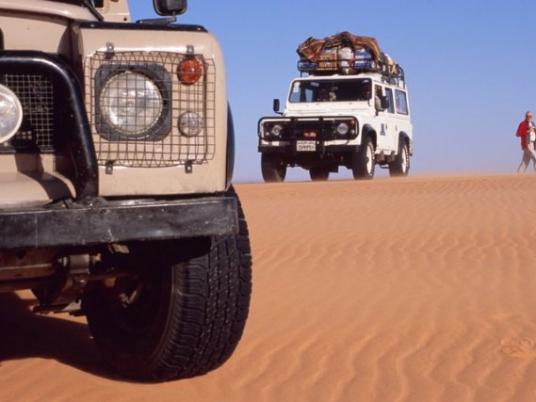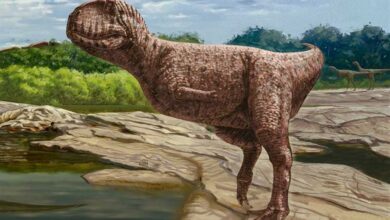
No one has ever struck me as more out of place than Mahmoud Marai in downtown Cairo. The lines on his face, carved a bit more profoundly by the rays of the harsh desert sun, his black wavy hair tied up in a low ponytail, and his sporty bicolor outfit of khaki and white stand out against the incessant honking of cars in the background.
“I don’t feel comfortable in Cairo,” he says, explaining that he was just stuck for 30 minutes in the suffocating metro that was encountering technical problems. “It’s funny, he says on the way to the shaded coffee shop a few blocks down from Groppi. “I cruise the desert all the time and it seems easier to navigate than Cairo; I feel lost here,” he says with a smile, pointing at Cairo’s usual exuberance.
Marai, in his late thirties, belongs to the dying tradition of great explorers, which seemed to have withered as the 20th century went by. Since 1997, he has been cruising oceans of sand and pebbles in Egypt, Libya, Sudan and Algeria’s mostly pristine deserts on the lookout for adventure, transcendence and milestone prehistoric and pharaonic discoveries.
But what may be most surprising is that neither his studies in chemistry at the American University in Cairo, nor his career as a teacher, had prepared him to become an adventurer of modern times, fiercely driving a sturdy and inexhaustible four-wheel car in the most remote locations of the Egyptian desert.
“The desert struck me by surprise,” says Marai with disarming honesty. “This happened in 1997, I remember a trip to Siwa with my cousin as a revelation. We had no idea on how to navigate the desert, but it was an exhilarating feeling.”
It was so exhilarating that Marai abandoned his school’s chemistry tubes and bubbly potions soon afterward, and prepared his first desert exploration of Gilf al-Kebir (the Great Barrier) a 7,700-square-kilometer sandstone plateau which rises 300 meters from the Libyan Desert floor in the remote southwest corner of Egypt.
The more he roamed these vast, barren lands, the more his knowledge in the area and his mechanical skills improved. “I kept transforming my Land Rover until it became the ideal desert vehicle,” says Marai who improved its resistance by changing the car’s engine with a Toyota diesel one, adding sand-resistant filters, and installing a heavy-duty roof rack and an air compressor to inflate and deflate the tires from inside the vehicle.
“I always carry 400 liters of supplementary fuel, a 40-liter water tank, and the spare parts of the entire engine to be on the safe side,” he says. It is quite ironic to hear him advocate for the safety of his desert expeditions when it is generally not recommended to cruise the desert solo.
“I admit that I rarely do explorations with other cars, but there is always someone riding with me wherever I go,” he says. He then launches into a story that is frightening to imagine.
“Once, I was in the desert with another guy from an oasis, when the car yelped a massive ‘paow!’ and stopped altogether. We were stalled, bewildered, in the middle of nowhere on a broken ship. The silence was thick. We had no satellite phone. I heard my companion swallow his saliva. Fortunately I managed to figure out which spare part had ceased to function, and we could change it and pursue our journey,” he says, shrugging his shoulders as if relaying an unimportant anecdote.
Marai’s many expeditions to the Western Desert permitted him to precisely map this vast area until he realized it was time to do longer explorations spanning months. “To do that, I needed external financing, and decided to bring other explorers on board to afford the very pricy long desert explorations,” he says.
Without realizing it at first, Marai was about to discover immemorial prehistoric rock art and murals, as well as traces of pharaonic presence hundreds of kilometers away from the Nile deep in the Western Desert, shattering some Egyptologists’ theories and adding primordial pieces of information to the history of Ancient Egyptians’ explorations.
But before detailing his findings and how they came about, Marai patiently goes back in time all the way to 1917, when the first exploration of the Western Desert was conducted. John Ball, a British archaeologist and the director of the Egyptian Desert Survey Department, discovered a hill located 180 km southwest of Dakhla Oasis. At the bottom of the hill, he found a hundred ceramic pots, broken pottery and amphorae. The Briton came up with a theory to explain the presence of the pottery, along with Prince Kemal Eddin Hussein, who visited the site seven years later. They hypothesized that the hill, baptized Abu Ballas (Father of Pots) was a station were pillagers of the infamous Bidayate Tribe deposited their loot.
In the 1930s, Hungarian desert explorer Lazlo Almasy proposed a more plausible theory, in which he suggested that Abu Ballas was a major water station for caravans moving from Zerzura to Dakhla. He speculated that other water stations must exist along the way, with the jars used as water depots.
Carlo Bergman, a German explorer, started roaming the Western Desert on foot, accompanied by three camels, in 1982. Having read most exploration literature, he set out to uncover the Abu Ballas mystery, and started looking for the ancient track that would lead Dakhla to the Uweinat Mountain, an isolated massif located at the junction of Egypt, Libya and Sudan’s borders.
He articulated the following hypothesis, wrote Marai in the paper “New Discoveries in the Western Desert,” which has been translated into Spanish and Italian. “The trade caravans of the Ancient Egyptians traversed the deep desert on donkeys in order to reach far-away destinations in Waday, Borkou and Lake Chad Basin,” postulated Bergman.
This theory, according to Marai, caused Egyptologists to smile in disbelief.
Finally, in 1999, Bergman succeeded in discovering an ancient donkey road deep in the desert with three water stations similar to Abu Ballas along the way, which he later mapped and called “Abu Ballas Trail.” Later on, he found a total of 27 water stations on the entire length of the trail, 440 km long, between the oasis of Dakhla and the Gilf al-Kebir plateau.
“This discovery was hugely significant because it attested that the trail was the first trans-Saharan road,” explains Marai, “and even more importantly that pharaonic expeditions went much further into the desert than previously thought.” Bergman’s discovery attested that the ancient Egyptians had extended the pharaonic administrations 80 km further out into the Western Desert.
In December 2007, during a 40-day desert expedition in the Uweinat — a hill deep in the Libyan Desert 700 km from the Nile — with Swiss desert photographer Hardy Boeckli, Marai ascended the 2,000-meter-high hill and discovered terraces and over 20 different rock art paintings in the mountain’s 10,000 year old caves.
“They depicted slender shepherds leading their cattle up the hill, and from the drawing we realized that the inhabitants of the Uweinat practiced vertical transhumance, leading their animals up the hill for grazing,” Marai explains.
Uweinat, first discovered by Egyptian explorer Ahmed Hassanein Bey in 1924 is located in one of the world’s most arid locations. But springs were discovered at the bottom of the hill, and biodiversity used to flourish there before the savannah vegetation gradually turned into a desert.
A couple of months later, when Marai did a second expedition to the Uweinat with Maltese explorer Mark Borda, they made a stupendous discovery: hieroglyphic writings and the cartouche of a king who was later identified as Nebhepetre Mentuhotep, a pharaoh of the 11th dynasty and the first pharaoh of the Middle Kingdom, engraved on the mountain.
“Beside the king we found inscriptions of two land-paying taxes to the pharaoh, the fabled land of Yam and Tekhbet,” he says, adding with much enthusiasm that “this was an extraordinary find because until then Egyptologists had been unable to locate the evasive land of Yam precisely; some thought it was somewhere in Sudan.”
This discovery has led explorers to conclude that instead of being limited to the borders of the Nile, ancient Egypt’s empire reached 700 km westward.
Marai is convinced that the Abu Ballas Trail theory put forward by Carlo Bergmann is actually justified, and he is ready to continue exploring the track westward beyond Uweinat all the way to Lake Chad, to locate the land of Yam. “Uweinat itself could be the land of Yam, although I doubt it,” explains Marai with much gusto. “I want to follow the trail all the way to the Erdi and Ennedi Chadian deserts to try to find other inscriptions that would confirm that Yam’s cradle is there.”
A month ago, Marai and a group of explorers hit the rocky desert roads of the Western Desert on board 1943 jeeps, looking for World War II jeep carcasses, abandoned airstrips and landing sites as a tribute to the Long Range Desert Group, a reconnaissance and raiding unit of British Forces that fiercely fought against Italian troops during the war.
“This type of expedition had never been done in this desert before,” says Marai, pointing out that all the jeeps’ engines were replaced by original 1943 motors, in order to travel back in time.




